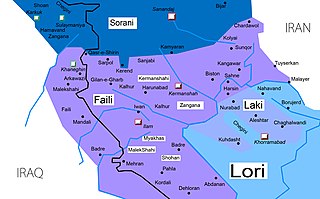Southern Kurdish: Difference between revisions
User:Semsûrî Okay then. I have added a reference. Tags: Reverted Visual edit: Switched |
Reverted good faith edits by Aram (talk): Check Wikipedia:Reliable sources. Blogs should not be used on Wikipedia. |
||
| Line 4: | Line 4: | ||
{{Infobox language |
{{Infobox language |
||
| name = Southern Kurdish |
| name = Southern Kurdish |
||
| nativename = کوردی باشووری |
|||
| nativename = کوردیی باشووری<ref>{{Cite web |title=ڕێنووس – فێرگەی زمانی کوردی |url=http://diyako.yageyziman.com/%DA%95%DB%8E%D9%86%D9%88%D9%88%D8%B3/#16 |access-date=2023-04-08 |website=diyako.yageyziman.com}}</ref> |
|||
| altname = |
| altname = |
||
| states = Eastern [[Iraq]], Western [[Iran]] |
| states = Eastern [[Iraq]], Western [[Iran]] |
||
| Line 33: | Line 33: | ||
{{legend|#b3d423|mixed dialect areas}}}} |
{{legend|#b3d423|mixed dialect areas}}}} |
||
'''Southern Kurdish''' ({{lang-ku| |
'''Southern Kurdish''' ({{lang-ku|کوردی باشووری ,کوردی خوارین|Kurdî Başûrî, Kurdî Xwarîn}})<ref>{{Cite web |title=Southern Kurdish |url=https://www.ethnologue.com/language/sdh/ |access-date=8 April 2023 |website=[[Ethnologue]]}}</ref> is one of the dialects of the [[Kurdish language]], spoken predominantly in northeastern [[Iraq]] and western [[Iran]].<ref>{{cite web |title=Kurdish language i. History of the Kurdish language |url=http://www.iranicaonline.org/articles/kurdish-language-i |publisher=[[Iranica Online]] |access-date=25 June 2019}}</ref> The Southern Kurdish-speaking region spans from [[Khanaqin]] in Iraq to [[Dehloran]] southward and [[Asadabad, Iran|Asadabad]] eastward in Iran.{{Sfnp|Fattah|2000|pp=VII}} |
||
== Name == |
== Name == |
||
Revision as of 13:32, 8 April 2023
| Southern Kurdish | |
|---|---|
| کوردی باشووری | |
| Native to | Eastern Iraq, Western Iran |
| Region | Kurdistan |
Native speakers | 3.7 million in Iran (2019) unknown number in Iraq |
Indo-European
| |
| Kurdish alphabet (Perso-Arabic script) | |
| Language codes | |
| ISO 639-3 | sdh |
| Glottolog | sout2640 |
| Linguasphere | 58-AAA-c |
 | |
 | |
Southern Kurdish (Kurdish: کوردی باشووری ,کوردی خوارین, romanized: Kurdî Başûrî, Kurdî Xwarîn)[1] is one of the dialects of the Kurdish language, spoken predominantly in northeastern Iraq and western Iran.[2] The Southern Kurdish-speaking region spans from Khanaqin in Iraq to Dehloran southward and Asadabad eastward in Iran.[3]
Name
'Southern Kurdish' is a linguistic term for a group of related dialects in Western Iran. Speakers are not familiar with the term and do not refer to the language as such. They generally identify the kind of Kurdish they speak as a local dialect (the Kurdish of a given village), or as a regional variety such as "Garūsi".[4]
Variants
Southern Kurdish has many variants, linguist Fattah divides them into 35 varieties. These include:
- Bicarî
- The most septentrional variety of Southern Kurdish spoken in and around Bijar in Iran. Bicarî is the only Southern Kurdish variety detached from the greater Southern Kurdish-speaking region.[5]
- Qorwa (Chahar Dawli xarbi)
- The Qorwa variety is spoken around Ghorveh in Iran and is related to the variety spoken in Asadabad and other Kurdish-speaking areas in Hamadan Province.[6]
- Kolyayî
- The Kolyayî variety is spoken northeast of Kermanshah, principally in Sonqor County and surrounding counties. The variety also spans into the Kolyai Rural District in Hamadan Province.[7]
- Bilawar
- The principal Southern Kurdish variety in Poshtdarband Rural District in Kermanshah.[8]
- Dinawar
- About 83 villages in Dinavar District speak the Dinawar variety. The differences between the Dinawar and the Kolyayî varieties are anodine.[9]
- Sahana / Lekî-Kirmaşanî
- The Sahana variety, or lakî-kirmashanî has many similar characteristics with Laki and is spoken in Harsin County and in Sahneh. What distinguishes it most from Laki is the lack of the ergative case.[9]
- Kordali a.k.a. Palai is quite distant, and may be a distinct language.[10]
Other variants include: Bîstûnî, Çihrî, Hersîn, Payrawand, Kirmaşanî, Sanjabî, Xalesa, Çemçemal, Qasirî Şîrîn, Serpuli Zuhawî, Harasam, Kelurî, Îwan, Erkewazî, Şêrwanî, Îlamî, Salihabad, Rîka, Badraî, Melikşahî, Mêxasî, Mihran, Xaneqînî, Mendilî, Duşêxî, Kaprat, Warmizyar, Zurbatiya and Feylî.[11]
Alphabet
The Southern Kurdish alphabet is very similar to the Central Kurdish (Sorani) alphabet, which is a derivation of the Arabic alphabet. Southern Kurdish has one additional letter "ۊ"; the Arabic letter waw with two dots above.
| ع | ش | س | ژ | ز | ڕ | ر | د | خ | ح | چ | ج | ت | پ | ب | ا | ئـ |
| 17 | 16 | 15 | 14 | 13 | 12 | 11 | 10 | 9 | 8 | 7 | 6 | 5 | 4 | 3 | 2 | 1 |
| ێ | ی | ۊ | ۆ | و | ە | ھ | ن | م | ڵ | ل | گ | ک | ق | ڤ | ف | غ |
| 34 | 33 | 32 | 31 | 30 | 29 | 28 | 27 | 26 | 25 | 24 | 23 | 22 | 21 | 20 | 19 | 18 |
See also
References
- ^ "Southern Kurdish". Ethnologue. Retrieved 8 April 2023.
- ^ "Kurdish language i. History of the Kurdish language". Iranica Online. Retrieved 25 June 2019.
- ^ Fattah (2000), pp. VII.
- ^ Anonby, Erik; Mohammadirad, Masour; Sheyholislami, Jaffer (299). "Kordestan Province in the Atlas of the Languages of Iran: Research process, language distribution, and language classification". Current issues in Kurdish linguistics. University of Bamberg Press. p. 26.
- ^ Fattah (2000), pp. 16–17.
- ^ Fattah (2000), pp. 18–19.
- ^ Fattah (2000), p. 19.
- ^ Fattah (2000), p. 20.
- ^ a b Fattah (2000), p. 21.
- ^ Erik Anonby, Mortaza Taheri-Ardali & Amos Hayes (2019) The Atlas of the Languages of Iran (ALI). Iranian Studies 52. A Working Classification
- ^ Fattah (2000), pp. 22–40.
Biography
- Fattah, Ismaïl Kamandâr (2000), Les dialectes Kurdes méridionaux, Acta Iranica, ISBN 9042909188
External links
- Information regarding Southern Kurdish
- Kurdish Academy of Language describing Southern Kurdish
- Audio recordings of wordlists and narratives in Southern Kurdish, archived with Kaipuleohone
- southern Kurdish Wikipedia
